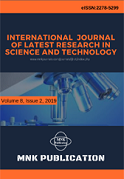DOI:10.29111/ijlrst ISRA Impact Factor:3.35, Peer-reviewed, Open-access Journal
Open Access
International Journal of Latest Research in Science and Technology Vol.9 Issue 6, pp 1-9,Year 2020
Correspondence should be addressed to :
Received : 02 December 2020; Accepted : 13 December 2020 ; Published : 31 December 2020

| Download | 127 |
|---|---|
| View | 183 |
| Article No. | 11008 |
What we do on land will affect the coastal and marine environment and what happens to these environments will affect us in return. Addressing land-based pollution is vital as the terrestrial is connected to the freshwater, the coastal and the marine system. We need to recognize that no one else is responsible for our lives and wellbeing but us. Biodiversity, defined by its genetic, species and ecosystem diversities, need to be conserved for the present and future. Genetic diversity is important for adaptations, species diversity sustains ecosystem equilibriums, and the robust performance of diverse ecosystems is crucial for the mix of life’s essentials. Its value extends far beyond fisheries providing natural products and services which life on earth depends on. These resources provide essential economic, environmental, aesthetic, and cultural benefits to humanity. Damage to the reefs due to multitude long term threats, and with the increasing pressure of human population and accelerated demands for food, products, services, and space from these environments, the health of marine biodiversity is becoming huge environmental issue. Globally, we are now left with a daunting prospect of undoing what we have done. Since the ocean and its biodiversity provide livelihoods and a place to live, they are the major contributors to the global economy and fundamental to global wellbeing; through direct and economic activities, provisions of environmental services, and as home to the majority of the world's population. The key issues affecting ocean and biodiversity sustainability have long been ascertained - unsustainable fishing, climate change and ocean acidification, pollution and waste, loss of habitats and biodiversity, and invasive species. Located at the heart of global biodiversity hotspot, the Coral Triangle is a shared marine resource heritage which is a fundamental link between our society, economy, and space. It contributes to the model of sustainability where community's wellbeing and livelihood depend on. A clear understanding of the role of CTI and how it fits into the SDG framework is imperative to see its connections to all the goals. It is also sensitive enough, when interrupted at any given point, to trigger a chain of reactions involving a broad spectrum of consequences to the biodiversity, environment, and the human society.
Copyright © 2020 Anisah Jessica Lee et al. This is an open access article distributed under the Creative Commons Attribution 4.0 International (CC BY 4.0) license which permits unrestricted use, distribution, and reproduction in any medium, provided the original work is properly cited.
Anisah Jessica Lee , " The Roles Of Coral Triangle Initiative (cti) In Realizing Sustainable Development Goals Within Asia Pacific Waters ", International Journal of Latest Research in Science and Technology . Vol. 9, Issue 6, pp 1-9 , 2020

MNK Publication was founded in 2012 to upholder revolutionary ideas that would advance the research and practice of business and management. Today, we comply with to advance fresh thinking in latest scientific fields where we think we can make a real difference and growth now also including medical and social care, education,management and engineering.

We offers several opportunities for partnership and tie-up with individual, corporate and organizational level. We are working on the open access platform. Editors, authors, readers, librarians and conference organizer can work together. We are giving open opportunities to all. Our team is always willing to work and collaborate to promote open access publication.

Our Journals provide one of the strongest International open access platform for research communities. Our conference proceeding services provide conference organizers a privileged platform for publishing extended conference papers as journal publications. It is deliberated to disseminate scientific research and to establish long term International collaborations and partnerships with academic communities and conference organizers.